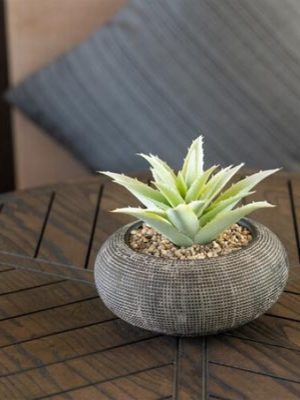
Know how to grow succulent plants in your home garden? Here are the tips
Succulents represent a unique category of plants characterized by their ability to store water in their leaves, stems, and roots. These plants are easily recognizable by their thick, fleshy appearance and are available in diverse shapes, colours, and sizes. Thriving in arid and hot environments, succulents have evolved to require minimal water for survival. Their adaptive features make them exceptionally low-maintenance and suitable for indoor and outdoor cultivation, making them a popular choice among home gardeners.
Beyond their aesthetic appeal and ease of care, succulents offer additional benefits. They are renowned for their air-purifying properties, contributing to improving indoor air quality. This added feature enhances the appeal of succulents as versatile and health-conscious additions to home and office environments.
What are Succulents?

Succulents are plants characterized by fleshy, thickened leaves and swollen stems that serve as water storage organs. “succulent” is derived from the Latin word “sucus,” meaning juice or sap. These plants have adapted to survive in arid conditions by efficiently storing water. They can thrive on limited water resources, such as dew and mist, making them highly drought-tolerant. Succulents encompass various species and cultivars, spanning multiple plant families. While many people commonly associate succulents with the Cactaceae family (cacti), it’s essential to note that while all cacti are succulents, not all succulents belong to the cactus family.
Succulents are known for their unique ability to thrive in various environments, making them popular choices for both indoor and outdoor gardens. Their striking and varied appearances, resilience, and adaptability contribute to the widespread fascination and cultivation of these fascinating plants.
Also Read This : Nurturing Succulents: A Comprehensive Guide to Watering
How to Grow Succulents Indoors

Succulents, known for their water-retention capabilities, thrive in warm, dry climates, making them well-suited for indoor growing. Their low-maintenance nature appeals to those seeking easy-care houseplants. If you’re new to succulents, follow these steps for successful indoor cultivation.
Choose an Appropriate Indoor Succulent
Select a succulent suitable for indoor conditions. While most succulents prefer direct sunlight, some, like the mother-in-law tongue, can tolerate low light. Consider plant label size, spread, and sunlight requirements before choosing.
Also Read This : Elevate Your Space: A Guide to Hanging Indoor Plants
Provide a Well-Draining Potting Medium
Report your succulent soon after purchase, as nurseries often use overly rich soil that retains too much moisture. Begin with a coarse potting mix that ensures good drainage and aeration. Specialized cactus and succulent mixes or African violet mixes work well. Enhance drainage and prevent compaction by adding perlite or pumice (up to 50% of the total mix). Pre-moisten the mixture before use for even moisture distribution.
Choose the Right Container
When repotting, select a container with drainage holes 1 to 2 inches larger than the nursery pot. Avoid long-term use of glass containers, as they hinder root breathing and may lead to root rot. Fill the bottom third of the container with pre-moistened potting mix, position the plant, and backfill with additional moistened mix.
Also Read This : Hibiscus Happiness: A Guide to Caring for Your Plant
Place in a Sunny Location
Position your potted succulent in a sunny spot, preferably near a south- or east-facing window. Most succulents thrive with at least 6 hours of sunlight daily. They may become spindly or stretch towards it if they lack sufficient light.
Allow Potting Mix to Dry Between Waterings
Prevent the common mistake of overwatering succulents by letting the potting mix dry between waterings. Water thoroughly, ensuring proper drainage, and allow the mixture to dry slightly before the next watering. Consistently wet soil can lead to plant deterioration.
Fertilize at Least Once a Year
Fertilize your succulents at least once a year for optimal growth. Apply fertilizer in spring, as days lengthen and new growth begins, and again in late summer. Use a balanced, water-soluble fertilizer (like 8-8-8 or 10-10-10) diluted to half the recommended strength. Avoid fertilizing in winter when succulents are semi-dormant and not actively growing.
Also Read This : Meet the Green Guardians – Houseplants live for Over a Century
Additional Succulent Care Tips

Can Sand be Used to Plant Succulents?
While succulents may seem to thrive in sand in their natural habitat, they prefer loose, rocky soil with adequate nutrients for optimal growth. When used independently, sand compacts over time, leading to excessive container water retention. The best potting medium for succulents is one specifically formulated for cacti and succulents or a well-draining mix comprising potting soil, coarse sand, and perlite or pumice.
Also Read This : From Feng Shui to Oxygen Boost: The Multi-Faceted Benefits of Snake Plants
Starting Succulents from Seeds
Yes, succulents can be started from seeds. Plant the seeds indoors in light, moist soil, similar to the process for other plant seeds. However, it’s important to note that succulents grown from seeds tend to grow slower and may only reach transplant size six months to a year after germination.
Also Read This : Easy and Budget-Friendly Herb Propagation from Cuttings
Why Are My Succulent Leaves Falling Off?
It’s normal for the lowest leaves on the stem, those closest to the potting mix, to eventually shrivel up and drop, much like many other plants. However, observing the topmost leaves dying could indicate overwatering, pests, or disease. Please pay attention to the overall health of your succulent and address any issues promptly to ensure its well-being.
Also Read This : How to Identify and Control Pests on Cacti




